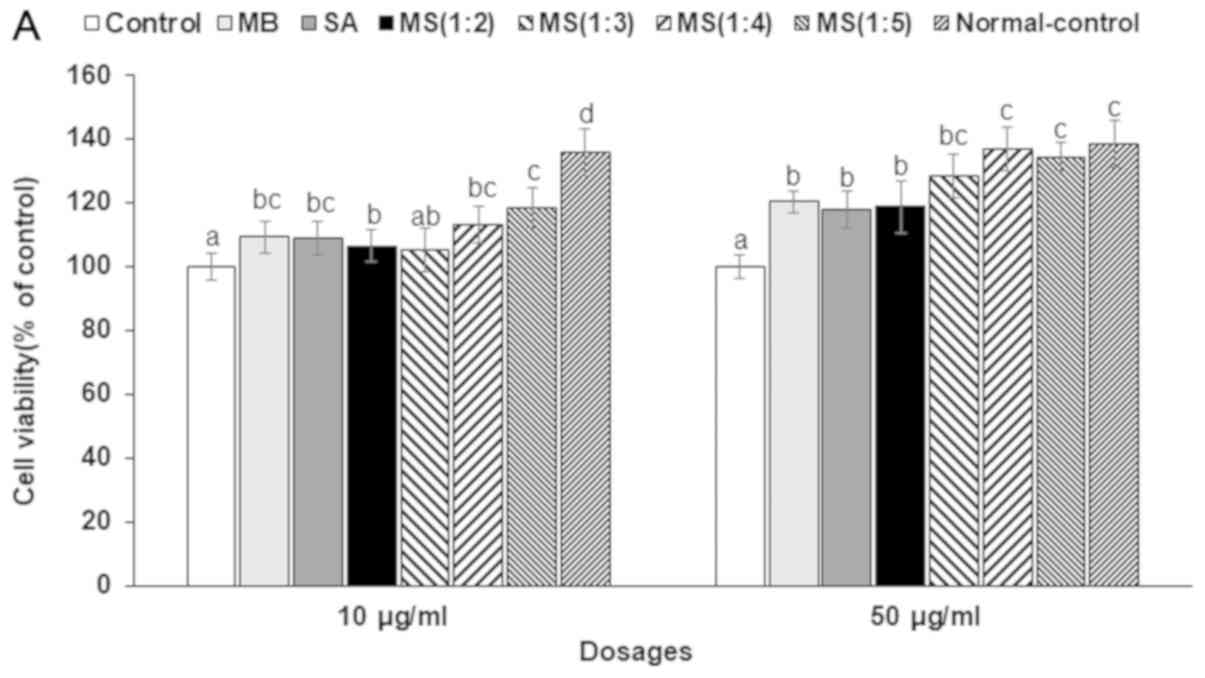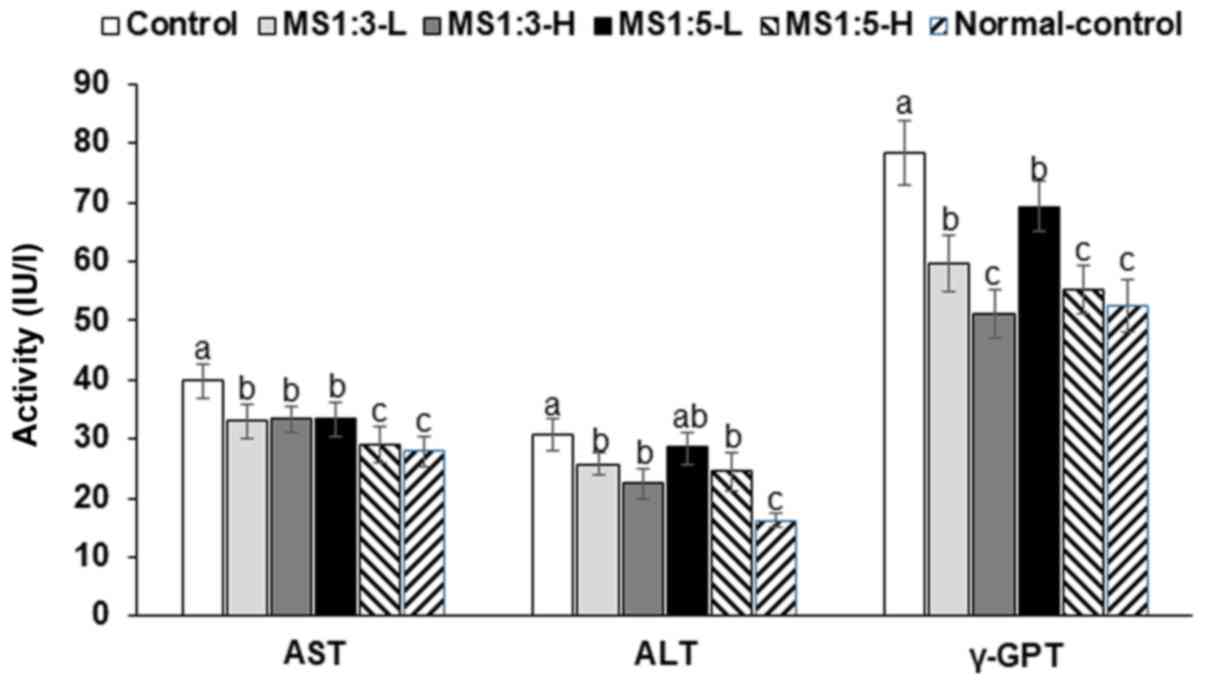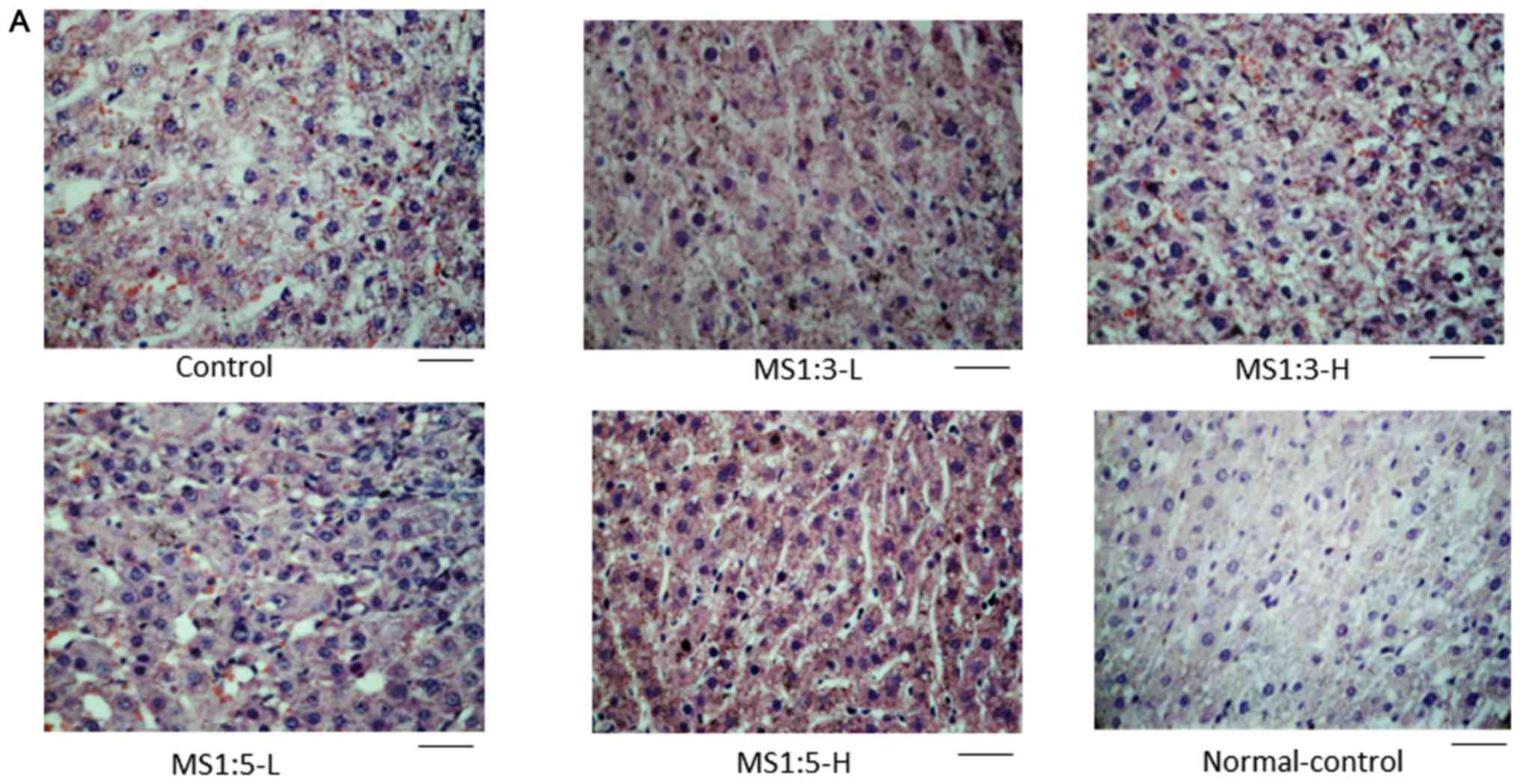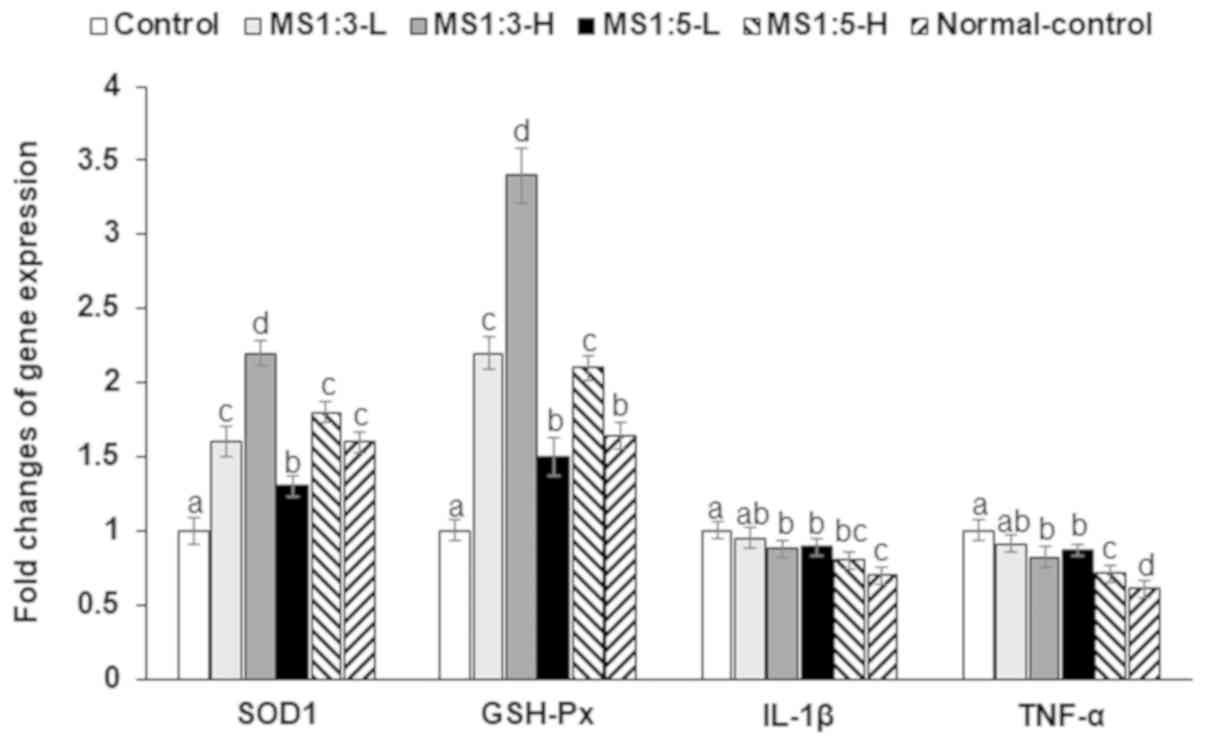|
1
|
Lim DW, Kim H, Park JY, Kim JE, Moon JY,
Park SD and Park WH: Amomum cardamomum L. ethyl acetate fraction
protects against carbon tetrachloride-induced liver injury via an
antioxidant mechanism in rats. BMC Complement Altern Med.
16(155)2016.PubMed/NCBI View Article : Google Scholar
|
|
2
|
Hsu LS, Ho HH, Lin MC, Chyau CC, Peng JS
and Wang CJ: Mulberry water extracts (MWEs) ameliorated carbon
tetrachloride-induced liver damages in rat. Food Chem Toxicol.
50:3086–3093. 2012.PubMed/NCBI View Article : Google Scholar
|
|
3
|
Radhiga T, Sundaresan A, Viswanathan P and
Pugalendi KV: Effect of protocatechuic acid on lipid profile and
DNA damage in D-galactosamine-induced hepatotoxic rats. J Basic
Clin Physiol Pharmacol. 27:505–514. 2016.PubMed/NCBI View Article : Google Scholar
|
|
4
|
Park S, Kim DS, Wu X and Q JY: Mulberry
and dandelion water extracts prevent alcohol-induced steatosis with
alleviating gut microbiome dysbiosis. Exp Biol Med (Maywood).
243:882–894. 2018.PubMed/NCBI View Article : Google Scholar
|
|
5
|
Decker K and Keppler D: Galactosamine
hepatitis: Key role of the nucleotide deficiency period in the
pathogenesis of cell injury and cell death. Rev Physiol Biochem
Pharmacol. 77–106. 1974.PubMed/NCBI View Article : Google Scholar
|
|
6
|
Ou TT, Kuo CY, Chyau CC, Lee HJ, Peng JS
and Wang CJ: Improvement of lipopolysaccharide-induced hepatic
injuries and inflammation with mulberry extracts. J Sci Food Agric.
93:1880–1886. 2013.PubMed/NCBI View Article : Google Scholar
|
|
7
|
Yan F, Chen Y, Azat R and Zheng X:
Mulberry anthocyanin extract ameliorates oxidative damage in HepG2
cells and prolongs the lifespan of Caenorhabditis elegans through
MAPK and Nrf2 pathways. Oxid Med Cell Longev.
2017(7956158)2017.PubMed/NCBI View Article : Google Scholar
|
|
8
|
Yang HJ, Kim MJ, Kang ES, Kim DS and Park
S: Red mulberry fruit aqueous extract and silk proteins accelerate
acute ethanol metabolism and promote the antioxidant enzyme systems
in rats. Mol Med Rep. 18:1197–1205. 2018.PubMed/NCBI View Article : Google Scholar
|
|
9
|
Lopez-Terrada D, Cheung SW, Finegold MJ
and Knowles BB: Hep G2 is a hepatoblastoma-derived cell line. Hum
Pathol. 40:1512–1515. 2009.PubMed/NCBI View Article : Google Scholar
|
|
10
|
Jeong SY, Kang S, Hua CS, Ting Z and Park
S: Synbiotic effects of beta-glucans from cauliflower mushroom and
Lactobacillus fermentum on metabolic changes and gut microbiome in
estrogen-deficient rats. Genes Nutr. 12(31)2017.PubMed/NCBI View Article : Google Scholar
|
|
11
|
Moon NR, Kang S and Park S: Consumption of
ellagic acid and dihydromyricetin synergistically protects against
UV-B induced photoaging, possibly by activating both TGF-β1 and wnt
signaling pathways. J Photochem Photobiol B. 178:92–100.
2018.PubMed/NCBI View Article : Google Scholar
|
|
12
|
Livak KJ and Schmittgen TD: Analysis of
relative gene expression data using real-time quantitative PCR and
the 2(-Delta Delta C(T)) method. Methods. 25:402–408.
2001.PubMed/NCBI View Article : Google Scholar
|
|
13
|
Lim HH, Lee SO, Kim SY, Yang SJ and Lim Y:
Anti-inflammatory and antiobesity effects of mulberry leaf and
fruit extract on high fat diet-induced obesity. Exp Biol Med
(Maywood). 238:1160–1169. 2013.PubMed/NCBI View Article : Google Scholar
|
|
14
|
Ganai AA, Khan AA, Malik ZA and Farooqi H:
Genistein modulates the expression of NF-κB and MAPK (P-38 and
ERK1/2), thereby attenuating d-Galactosamine induced fulminant
hepatic failure in Wistar rats. Toxicol Appl Pharmacol.
283:139–146. 2015.PubMed/NCBI View Article : Google Scholar
|
|
15
|
Sakaguchi S and Yokota K: Role of Ca2+ on
endotoxin-sensitivity by galactosamine challenge: Lipid peroxide
formation and hepatotoxicity in zymosan-primed mice. Pharmacol
Toxicol. 77:81–86. 1995.PubMed/NCBI View Article : Google Scholar
|
|
16
|
Li YG, Ji DF, Chen S and Hu GY: Protective
effects of sericin protein on alcohol-mediated liver damage in
mice. Alcohol Alcohol. 43:246–253. 2008.PubMed/NCBI View Article : Google Scholar
|
|
17
|
Tang CC, Huang HP, Lee YJ, Tang YH and
Wang CJ: Hepatoprotective effect of mulberry water extracts on
ethanol-induced liver injury via anti-inflammation and inhibition
of lipogenesis in C57BL/6J mice. Food Chem Toxicol. 62:786–796.
2013.PubMed/NCBI View Article : Google Scholar
|
|
18
|
Saracyn M, Zdanowski R, Brytan M, Kade G,
Nowak Z, Patera J, Dyrla P, Gil J and Wankowicz Z: D-galactosamine
intoxication in experimental animals: Is it only an experimental
model of acute liver failure? Med Sci Monit. 21:1469–1477.
2015.PubMed/NCBI View Article : Google Scholar
|
|
19
|
Ganai AA and Husain M: Genistein
attenuates D-GalN induced liver fibrosis/chronic liver damage in
rats by blocking the TGF-β/Smad signaling pathways. Chem Biol
Interact. 261:80–85. 2017.PubMed/NCBI View Article : Google Scholar
|
|
20
|
Banu S, Bhaskar B and Balasekar P:
Hepatoprotective and antioxidant activity of Leucas aspera against
D-galactosamine induced liver damage in rats. Pharm Biol.
50:1592–1595. 2012.PubMed/NCBI View Article : Google Scholar
|
|
21
|
Do SG, Park JH, Nam H, Kim JB, Lee JY, Oh
YS and Suh JG: Silk fibroin hydrolysate exerts an anti-diabetic
effect by increasing pancreatic β cell mass in C57BL/KsJ-db/db
mice. J Vet Sci. 13:339–344. 2012.PubMed/NCBI View Article : Google Scholar
|
|
22
|
Song Z, Zhang M, Xue R, Cao G and Gong C:
Reducing blood glucose levels in TIDM mice with an orally
administered extract of sericin from hIGF-I-transgenic silkworm
cocoons. Food Chem Toxicol. 67:249–254. 2014.PubMed/NCBI View Article : Google Scholar
|
|
23
|
Farah BL, Sinha RA, Wu Y, Singh BK, Lim A,
Hirayama M, Landau DJ, Bay BH, Koeberl DD and Yen PM: Hepatic
mitochondrial dysfunction is a feature of Glycogen Storage Disease
Type Ia (GSDIa). Sci Rep. 7(44408)2017.PubMed/NCBI View Article : Google Scholar
|
|
24
|
Henrique da Silva G, Barros PP, Silva
Goncalves GM and Landi MA: Hepatoprotective effect of Lycopodium
clavatum 30CH on experimental model of paracetamol-induced liver
damage in rats. Homeopathy. 104:29–35. 2015.PubMed/NCBI View Article : Google Scholar
|
|
25
|
Irimia JM, Meyer CM, Segvich DM, Surendran
S, DePaoli-Roach AA, Morral N and Roach PJ: Lack of liver glycogen
causes hepatic insulin resistance and steatosis in mice. J Biol
Chem. 292:10455–10464. 2017.PubMed/NCBI View Article : Google Scholar
|
|
26
|
Crescenzo R, Bianco F, Mazzoli A, Giacco
A, Liverini G and Iossa S: A possible link between hepatic
mitochondrial dysfunction and diet-induced insulin resistance. Eur
J Nutr. 55:1–6. 2016.PubMed/NCBI View Article : Google Scholar
|


















